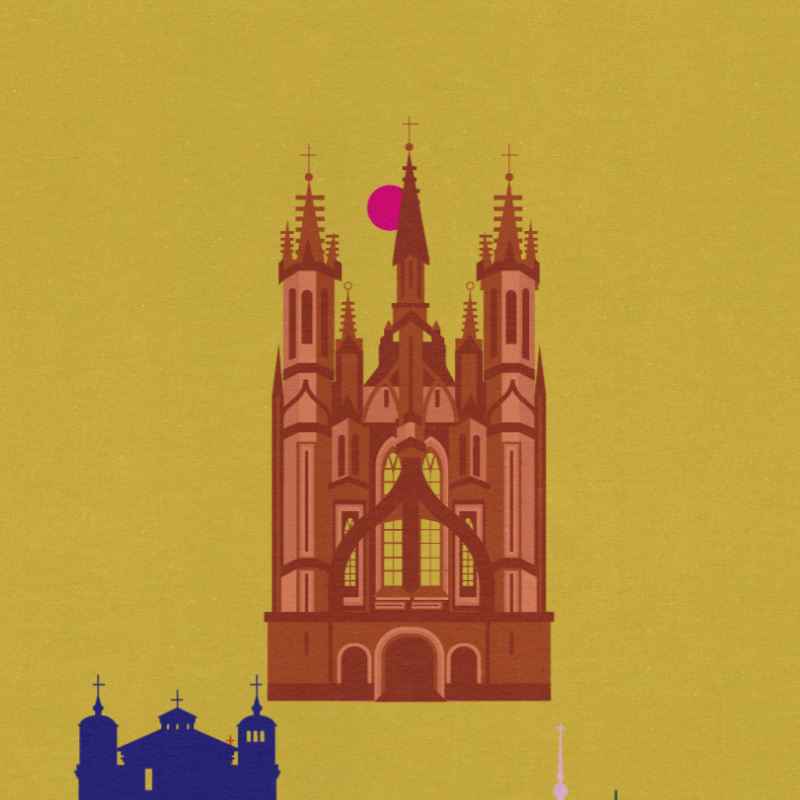Vilnius, The Capital of Lithuania – a City of Churches
> BACK TO 100 STORIESDue to its exceptional architecture – narrow medieval streets and ornate baroque buildings – Vilnius Old Town is one of the most visited places by both its residents and tourists. The Old Town is also unique because there are many churches – Christian houses of worship – in different styles. So the saying “there is a church wherever you turn” in Vilnius is real. For example, in the very heart of the Old Town, near the Vilnia River, there are three churches right next to each other – St. Anne’s, Bernardine (St. Francis of Assisi) and St. Michael the Archangel’s. A number of churches have also been built in new districts of Vilnius.
There have always been many churches in Vilnius. At the beginning of the eighteenth century, there were about forty houses of prayer in the central part of the city. Although most Lithuanians are Roman Catholics (Lithuania adopted Christianity in 1387), the city also has houses of worship for believers of other religions: thirteen churches (one of which is an Old Believers’ church), a synagogue (Jewish place of worship), and a kenesa (Karaite house of worship). There was also a Muslim mosque in Vilnius. Unfortunately, it was demolished in 1968, but Mečetės [Eng. Mosque] Street has survived to this day.
The houses of worship built before Lithuania’s conversion to Christianity did not survive, so the oldest are the Gothic churches. They are easily recognizable as the buildings rising to the sky: the Gothic churches are tall with predominantly vertical lines, graceful pointed arches, and many towers. The famous St. Anne’s Church is called a Gothic pearl. Although many surviving churches were built as Gothic, most of them were destroyed during the wars, fires and other disasters, and rebuilt in a different style.
Most of the churches in Vilnius Old Town are Baroque, which is why the capital is called a baroque city, a flash of late baroque in Europe. The Italian word barocco means bizarre and uselessly complicated. Baroque buildings are not high, but they are quite large and extremely ornate. They are characterized by the impression of life, movement, and even disorder. Most of the Catholic and Orthodox churches and monasteries in Vilnius were built when the Baroque style was flourishing (early-seventeenth to mid-eighteenth century). The most impressive baroque churches in Vilnius are the Church of St. Peter and St. Paul, the Church of St. Catherine, and the Church of Sts. John. The latter two, like many other baroque buildings in Vilnius, were designed by the architect Johann Christoph Glaubitz.
The only surviving Renaissance church in Vilnius is the Church of St. Stephen. The most famous and important Classicist style house of prayer, which is recognizable by its strict lines, is the Vilnius Cathedral. The cathedral was designed by the architect Laurynas Gucevičius at the end of the eighteenth century.
Every church in Vilnius has its own history. A popular myth is that St. Anne’s Church was so beautiful that Napoleon Bonaparte, who visited Vilnius, wanted to take it in the palm of his hand and carry it away with him. The Church of Sts. John belongs to Vilnius University, which was founded by Jesuit monks, therefore the opening and closing celebrations of the academic year take place there every year. The Church of St. George is currently closed, but it was called the House of Books during the years of the Soviet occupation because from 1946 it was used as a storage facility for old publications and as a bibliography – publication description, classification – center. By imposing universal censorship and denying freedom of speech and the press, the Soviets destroyed books that contradicted their ideology. Some of these books were hidden in the niches of this church. The Soviets forbade religion and closed churches: some were turned into warehouses, and from 1966–1988 the Museum of Atheism, which denies religion, operated in the Church of St. Casimir. Some churches have not yet been consecrated, so worship services cannot take place in them. Such buildings are used as cultural spaces for concerts and exhibitions.

